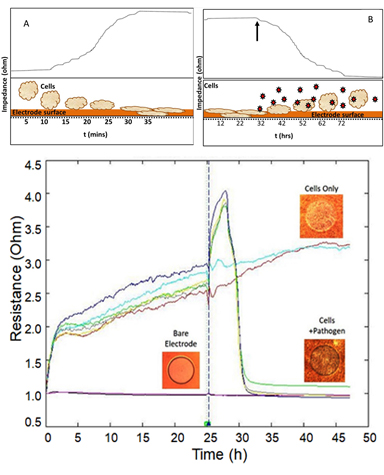Cytotoxicity effects on cells have been notoriously difficult to measure simply because the methods have been qualitative in nature rather than quantitative. With ECIS® technology, cell toxicology and viability can be quantitatively measured in real-time, continuously and label free, all while under incubated conditions.
ECIS® technology has long been used to detect proliferation and viability of cells by measuring electrical impedance changes as cells grow over gold electrodes at the bottom of culture dishes. Since cell proliferation can be detected through electrical impedance as these cells attach spread over the electrodes, so can cell death be detected as the cells detach from the electrodes. Through ECIS® software, as cells attach and spread, the impedance levels will rise and reach a plateau representing confluency, and when a cytotoxic substance is introduced such as a pathogen, the impedance levels will drop as the cells die and detach from the gold electrode substrate as shown in the A & B diagrams. The graph to the right shows an example of this where A549 adenocarcinomic lung epithelial cells were treated with MRSA. As you can see in the graph, when the cells were treated with the pathogen the cytotoxic effects take place and the impedance reduces down to cell-free levels indicating a cleared electrode from cell death.

An evaluation of the impact of clinical bacterial isolates on epithelial cell monolayer integrity by the electric Cell-Substrate Impedance Sensing (ECIS) method., Nahid, Md A.,Campbell, Carmen E.,Fong, Keith S.K.,Barnhill, Jason C.,Washington, Michael A. (2020). Journal of Microbiological Methods 169 105833 doi:10.1016/j.mimet.2020.105833 [Abstract]
To view publications in cytotoxicity please visit our publications page
© 2026 Applied BioPhysics, Inc.
185 Jordan
Road Troy, NY 12180 / Phone: 518-880-6860 / Toll Free: 866-301-ECIS (3247) / Fax: 518-880-6865